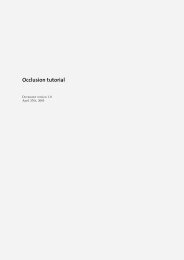mental ray Architectural and Design Visualization Shader Library
mental ray Architectural and Design Visualization Shader Library
mental ray Architectural and Design Visualization Shader Library
You also want an ePaper? Increase the reach of your titles
YUMPU automatically turns print PDFs into web optimized ePapers that Google loves.
78 3 Sun <strong>and</strong> SkyFG with 250 <strong>ray</strong>s <strong>and</strong> density 0.8 FG with 500 <strong>ray</strong>s <strong>and</strong> density 1.5Yes, increasing the number of <strong>ray</strong>s <strong>and</strong> the density helps but it hurts our render time a lot.Even at the high setting we are still not near the optimal result. We would have to go evenhigher to resolve all the detail!Lets back down from the high FG settings for a moment <strong>and</strong> concentrate on light transport.The scene is still very dark, because we are only getting a single FG bounce, <strong>and</strong> since thelighting from the sky is indirect we get no bounce of that light! Meaning: In this scene, thesunlight is bouncing once, but the skylight is not bouncing at all!Lets turn up the number of bounces to 3:FG with 3 bouncesThis gave us more light. Due to the fact we stepped back from our “high” FG settings, thelighting isn’t smooth <strong>and</strong> lacks any detail.Using FG multi-bounce is just one of the ways <strong>mental</strong> <strong>ray</strong> can transport light in a scene. Thealternative is to use Photons (GI). But keep in mind that when Photons are enabled, FG goesback to a single bounce, letting photons h<strong>and</strong>le all the remaining bounces:
















